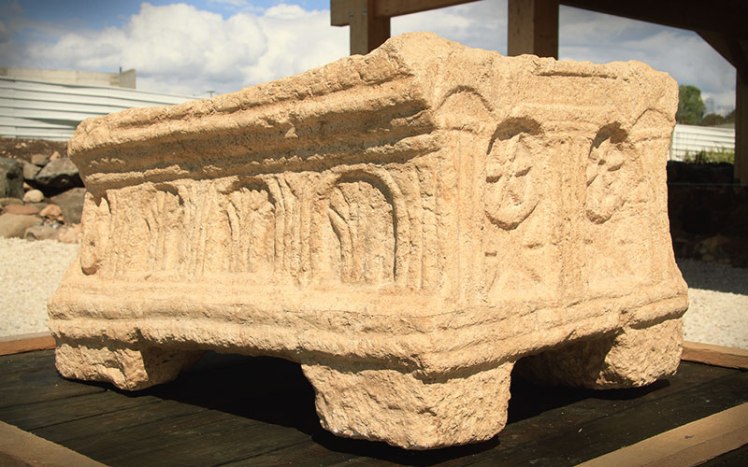
Dedicated To All Women Followers Of Jesus
Over the years on trips to Israel, driving along the Sea of Galilee from Tiberias to Capernaum, we would see an intriguing archaeological dig in progress on the western shore of the lake, tantalizingly near the Mount of Beatitudes, Mensa Christi and other Galilean sites. Finally in 2014, the incredible excavation of the village of Magdala opened to the public. During all those previous trips, we knew it would be an important site for those of us walking in the footsteps of Jesus, but in an extraordinary way, the site has highlighted the significance of women in the ministry of Jesus.

Mary Magdalene’s Home Town
While 1st century Magdala (MAG-duh-luh) was an important port on the Sea of Galilee, a center of commerce and the ancient fishing industry written about in the Gospels, it was also the hometown of Mary Magdalene, who has fascinated the world throughout the ages. Scholars, historians and religious leaders, from Josephus to Pope Gregory the Great and the current Pope, have written, preached and pontificated upon the character and Gospel significance of Mary. She has been variously said to have been a prostitute, an ill women afflicted with demons, a wealthy woman who followed and used her wealth to support Christ’s ministry and finally an Apostle to the Apostles. All are most likely true, but the one that is the truest is follower, a woman who was the first to see the Risen Christ, the first to receive a message from Him, the first to tell the disciples He had risen and to tell them where they were to meet Him.

A Life Transformed
God’s word and accounts of Mary Magdalene give us all the information we need to know about the value of this woman to Christianity. It is a reliable witness to a life that was delivered from some type of torment through a miracle by the hand of Jesus and transformed into a life devoted to Him; such a dedicated follower that she never left Jesus’ side during His most agonizing hour and what must have been her most terrifying moments.

The Magdala Stone
At Magdala are several significant finds, including a synagogue where scholars and antiquity experts are certain Jesus taught, and the “Magdala Stone” considered by many to be one of the most outstanding finds in the last 50 years. Carved into the stone is the oldest Menorah found to date as well the only Chariot of Fire found in Israeli archaeology. These symbols all date to the Second Temple Period, the time of Christ’s three year ministry.

A 1st Century Village
According to the Israeli antiquity authorities, only about 15% of the Magdala site has been uncovered to date. Even so, besides the above mentioned synagogue and stone, an entire village has been excavated, an ancient market place, the remains of a thriving fish processing industry, a wharf and pier, coins dating to 29AD, pottery shards and at least three ritual Jewish mikvahs or baths.

Josephus Lived There Too
Another well-known 1st century resident of Magdala is the historian, Josephus. Known as Yosef ben Matiyahu, Josephus governed the Galilean province and made his home in Magdala. As the Jewish nation began to implode during the Great Jewish Revolt, he erected a defense wall around the city and encouraged rebels to gather there. In 67 AD Roman forces under the command of Vespasian began a siege of Magdala and after her fall, several things that impacted history happened. For one, Josephus, upon being captured, made a deal with Vespasian in which he convinced the Roman general to allow him to chronicle the ensuing Jewish-Roman wars, and other historical exploits of the Roman Empire. Second, Magdala was leveled and became a forgotten city buried under the debris of war and the elements.

The “Ancient Boat” Connection
As Magdala lay in ruins and Josephus surrendered, he writes that the city had a population of 40,000 and boasted a fleet of 230 boats. Most of the residents fled Magdala via the boats onto the Sea of Galilee where they succumbed to the water or Roman weapons. Some believe that the “ancient boat” found and preserved nearby at Nof Kinosar maybe one of those boats sunk by the Romans during the siege of Magdala.

A Retreat For Jesus and Christians
As with most archaeological finds in Israel, Magdala was discovered under a modern day construction site. In 2004, the Reverend Juan M. Solana was inspired to build a spiritual retreat center for pilgrims in the vicinity of the Sea of Galilee, the same area where Jesus loved to spend time. Following Solana’s dream, four plots of land between Tiberias and Capernaum were acquired and plans drawn up.

Archaeology Rules In Israel
By 2009 all was in place to begin construction and the site was ready for the routine antiquities dig, a requirement for any type of construction in Israel….You never know what you will find even if you are only remodeling a bathroom! But less than two feet under the dirt, diggers struck something hard and the Magdala Stone saw the light of day for the first time in 2000 years and the long forgotten hometown of Mary Magdalene appeared.

Dedicated To Women
Today, not only is the village, market place and ancient synagogue available for you to walk through, there is a beautiful chapel, containing an altar shaped like a fishing boat, dedicated to the women of the New Testament. In the chapel are eight columns, seven with the names of New Testament women who, along with Mary Magdalene, were instrumental in spreading the Gospel of Jesus, Joanna, Susanna, Mary, Martha and others. The eighth column is left unnamed for YOU to add your name to those women of faith across time that have followed and loved Jesus Christ.